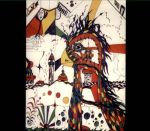. issue III : iv .
. artist : günter schickert .
. album : samtvogel .
. year : 1974 .
. label : important .
. grade : a .
German-born Günter Schickert, whose “name barely registers among most of the Krautrock intelligentsia,” was an active devotee of the Berlin jazz scene in the 60’s who didn’t make his first solo album until 1974. Initially, it was a small-batch private release, later picked up by the venerable Brain label, the outfit responsible for getting out Neu!, Guru Guru, Embryo, and even the Scorpions (undoubtedly when it was still fun). Between June and September of ’74 and with only what he had on hand, Schickert put his own brain and fingers to work, and the result of that flurry of activity was Samtvogel.
“When I was recording Samtvogel in 1974 I had only two tape recorders. I played one track and while listening I added the second one. And so on. Four times. When I mixed all together I borrowed a third tape recorder, and still added the last track to the master. I had a small mixer with two stereo and one mono, but it was possible to pan tracks. No equalization. It all came out of my still living G2000 Dynacord guitar amplifier — of course, valve, with no master, even the voice recorded through it. If I made a mistake in one track I had to repeat it from the beginning. And if while mixing I was not fast enough in changing the tape I had to start again. So it took me more than three months to get ready.” –Günter Schickert
Schickert, whose main instrument was the guitar, had made some sessions of ‘echo-guitar’ before Samtvogel (not dissimilar to Achim Reichel of A.R. & The Machines fame), but this is where it apparently all came together in classic form. Samtvogel is not only a prime serving of early Krautrock pioneering with acid flares, but a gem of experimental (as well as personal) music. With echo-guitar in hand, Schickert laid down three cuts that go exponentially beyond that small number. The 6-minute “Apricot Brandy” eases in, minimally and deceptively, laying down more than one path that Samtvogel will expand down with the lengthier “Kriegsmaschinen, Fahrt Zur Holle” and “Walde.” “Kriegsmaschinen, Fahrt Zur Holle” builds slowly, layering up on itself until it becomes a vibrating push that doesn’t just cut through the air–here and up there—but infuses itself with it. It’s a chiming, shimmering and at times delicate, loopy vortex that has as much going on outside it as it does inside; like a soundtrack to a chemical reaction, randomly choreographed particles bounce and ricochet off of each other, generating new energy. Schickert weaves in some vocals that resonate with what’s coalescing sonically, giving “Kriegsmaschinen, Fahrt Zur Holle” even more lift, but also a tether to the human factor of the trip, as alien as it all feels. “Walde” moves the flurry to the front end, thickening the pulse and flattening the curve a bit, as sounds and proddings push in from all sides, exploratory fingers testing the flexibility of the force field Schickert is provoking out of thin air. “Walde” has the feeling of being broken into sections, but the demarcations are so fluid and bleeding into each other that drawing a line in the sand is pointless.
“Not being able to decide if the trip is inner or interstellar is a huge part of this track’s pull and Samtvogel‘s gravity.”
In part because of it’s initial limited ‘private’ run and personal nature, Samtvogel was difficult to put your hands on so that you could experience trying to get your brain around it. In another example of forward thinking by looking back, April sees a reissue of this personal and seminal Krautrock gem from Important Records.
by Mr. Atavist

